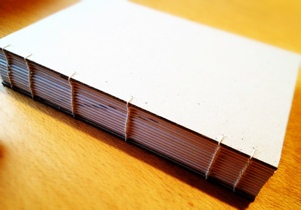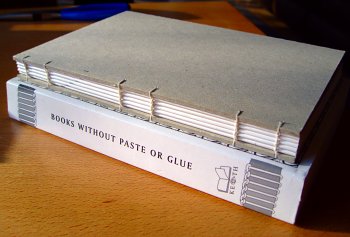Sewed another scratch book for work. The paper is Mowhawk Superfine, with plain low-acid boards, and linen thread. I used the Coptic sewn binding technique from Keith Smith’s first non-adhesive binding book. I’ve used this on a lot of projects, and I really like the look, durability, and that it allows the books to lay completely flat.
I had originally planned on twelve sections, each made from eight letter sized sheets (short grain) folded in half, but as always, I forget that the last section and the final board are sewn together, so I added a thirteenth section. Thirteen sections, eight pieces of paper, four pages per piece equals a book of 416 pages.
At ABR, we use a notebook (our “black book”) to keep track of what we were doing for the hours we charge to our clients. I’d been using the notebook I made a couple years ago, but ran out of pages on Friday, so today I made another one. The coptic style is really great for this sort of thing because it will lie completely flat on the desk, and there’s no glued binding to break. Yesterday we went to If Only here in town and I almost bought a Moleskine sketchbook, but I put it back on the shelf because I wasn’t sure it’d lay flat. Their normal notebooks will, but the pages are much too thin for fountain pens unless you only write on one side of the page. So often it seems there’s no substitute for doing something yourself so you can make sure it’s done right.
Sigh.
The covers are plain, acid-free book boards that are normally covered with book cloth or leather, but I’ll just slip it into the leather book cover I used with my previous notebook so the boards won’t show until I’m done with the notebook. The paper is Mohawk Superfine, cut into short-grain pages by my supplier, folded into five 32-page sections (8 pieces of paper folded in half = 32 pages), and sewn together with linen thread using a sewing technique that’s several thousand years old. Last time I had trouble doing all the stitching with a straight needle so I bent a needle by heating it red hot over the stove, bending it into a curve, heating it to red hot a second time before quenching it in cold water. The tip could probably use some sharpening after the heat treatment, but it worked well as is.
The whole project took less than two hours and required very few supplies.

